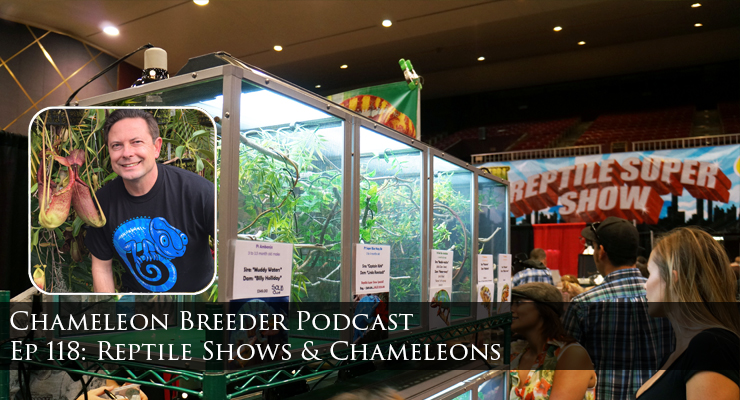
Are You Going To The Reptile Super Show? Find This Guy!!

Come say Hello Saturday, Aug 10, 1PM in front of the Kammerflage Kreations Booth!
Do You Want Info On This Show? Click Here!
Audio Transcript - more or less....
Reptile shows are a blast to go to. You get to see your favorite local vendors and the national brands all in one space. Today we are going to talk about chameleons and reptile shows.
As I record this I am preparing to visit one of the West coast’s largest reptile shows – the Reptile Super Show in Pomona which is a city in Los Angeles, California. I will start to vend shows soon, but this weekend I am just visiting as one of the mob. I have no intention of adding anymore members to my personal Jurassic Park. But I do have more cash on me than usual, just in case…So today we are going to talk about shopping at reptile shows.
Reptile shows are a great opportunity to purchase a chameleon. Now I am sure you are tired of hearing me harp on researching first before you purchase. I fear I will offer you no respite on this episode. Going to the show with a bunch of cash and an open mind is a heck of a lot of fun, but is a very bad idea. Each of these reptiles has different needs and I am sorry to say that the show is not a good place to learn about a new reptile. Oh, the vendors will certainly give you the “its easy” talk. Kind of like that 5 minute youtube video on how easy it is the put up a deck for your backyard. You will be sent away feeling like you can do it.
But let’s talk specifically about chameleons. If you are listening to this podcast you are what we would call a sophisticated customer. The only way to find this podcast is if you are looking which means you are researching. Even if you are still taking it all in and wouldn’t dare consider yourself expert enough to give advice, if you have spent any time listening here you will have just absorbed at least a general feeling for things. In all my talking about plants and a floating garden and a living environment you are going to look at the aquarium with woodchips on the bottom and one stick leaned from corner to corner and a chameleon half the size of the cage and you are not going to think “wow, if that is all I need, keeping a chameleon is going to be easy!”. You are going to be thinking. “I cant put my finger on it, but something tells me that isn’t what Bill is talking about when he says your chameleon should be able to disappear into the floating garden in your cage.” Unfortunately, many customers at the show will be leaving with inadequate equipment and a new found excitement which is going to be left in a heap of whimpering ashes when they go on social media to show the cage set-up that the show vendor said was all they needed for their pair of veiled chameleons.
But the fact that you are listening to this means you are in the community. It doesn’t matter how many times you have or haven’t been around the block. You are ahead just by knowing that the block exists and where to find it! And you know enough to catch me on the fact that I have no plans to bring anything home, yet I am bringing cash. Well, I have been around the block a couple of times and I will give you a secret. Spend the year researching every possible option and have a garage full of various types of cages, lights, misting systems, and have an active feeder breeding project that supports everything from baby chameleons to adult parson’s chameleons and suddenly, you can honestly say you have researched everything and are completely ready for anything the show can throw at you! And, yeah, my wife didn’t buy that either…oh well. And she is wise to my tricks by now. She can ask that probing question “So….what are you planning to bring home?” just ASSUMING I would think of bringing something home. The nerve! And, of course, I’ll tell the truth and I’ll say something like “You know, I really don’t think there will be any chameleon’s there that I will want.”
Moment of silence as I wonder if I got away with it and she ponders my audacity to think I could get away with that.
“I should hope not since the only two cages sitting empty are suspiciously set-up like they would house a captive born juvenile emerald tree boa or a couple of dart frogs.”
And this, my friends, is the danger of being married to a reptile savvy spouse.
Bill, what is in this cage?
Oh, just a bunch of nepenthes plants and satin pothos. Cool, huh?
Her eyes slightly narrow
Bill, what is going to be in this cage?
Now, I am sure you will all back me up here, if your spouse doesn’t know the difference between when the cage is just raising cool nepenthes tropical pitcher plants and when there is a quiet arboreal reptile in it – does it really count?
Of course, I am just kidding. Do NOT surprise your spouse with a new reptile. That is just trouble. Seriously. And I am also kidding about those conversations back and forth with my very cool wife Yvette. Although we actually do have those conversations it is all in jest as she tests how clever I can be squirming out of her interrogation. Truth be told, SHE has been to a couple of reptile shows unsupervised. And I have had those “Hey, honey, ummm….how are you doing?” calls on her way back from the show. But I admit, her indiscretions are on the level of buying four orchids even though she only needed three and she is clearing her heavily burdened conscious. On the other hand, I have been known to use the words “breeding group” on my phone calls home with a conscious not nearly burdened as much as it should be. So, yeah, it is not hard to tell who needs more adult supervision.
But let’s talk about shopping for chameleons at the show! I am sure you know by now that a reptile show is the place where you will run smack dab into the wild caught vs. captive bred dilemma. Ha! Trick question. There is no dilemma. No wild caught! Captive bred only! But here is where you will have your greatest temptation to make that oooonnnnnnne exception. A beautifully colored or horned adult at fully half the price of a little brown baby thing. It looks healthy enough! Why spend the money for the baby? I am hoping you are enjoying the drama of this as opposed to actually asking that question. Because , unless you are experienced and need this rare adult for your breeding group, wild caught chameleons should not even rate consideration. Captivity stress, parasites, importation health issues…there is so much that is not visible on the surface. If you want a pet chameleon, please don’t get distracted by the wild caught adults. There are many captive bred babies available. They are more expensive and rightfully so. It is very worth it. Especially if you buy from a breeder that will be there to help you care for that baby throughout its life. We have a culture where the dollar amount is of prime importance. We will give up quality or long term value for immediate savings. This is a bad idea when it comes to living chameleons.
I wish that could be the only test. Unfortunately, you have to be careful with captive born or hatched babies. Veiled Chameleons are surprisingly easy to breed which is evident by the aquariums full of veiled chameleon babies sitting on the corner of the table of someone who imports snakes. Really, it takes very little to reproduce veiled chameleons. And this vendor is doing it to have something to sell. Here is where you have $25 veiled chameleons. At the end of the show this vendor will not want to take home these endless pits of eating and soon to be fighting. So, this is giving you an idea of what kind of care these chameleons are getting. Do you think this “breeder” in quotes, really has researched nutrition? Or has cared at all about separating out the larger bullying babies?
It is even worse with Jackson’s Chameleons. Where it takes very little to get veiled chameleon babies, it takes even less to get Jackson’s Chameleon babies. All they have to do is get a bunch of Hawaiian Jackson’s in and kept in a sparse cage and babies will be born. And these people will want to sell jackson’s babies as soon as possible. Unfortunately, Jackson’s babies are not the little tanks that veiled chameleons are. Where veiled chameleons will take and hide a lot of abuse, Jackson’s Chameleons will reward your neglect by dropping dead. So these vendors will want to sell their Jackson’s Chameleons way too small to go to a new home. At the Kenyan Xanth Project we hold babies at least four months, but often 6 months before sending to a new home. I think you’ll be able to tell if the person selling captive born Jackson’s is a serious breeder sharing their art or just someone who picked up ten chameleons wholesale and got babies in the two weeks they kept the mothers alive.
But a show is an excellent place to go and meet the breeder you have been emailing back and forth for months. These shows are an important component to our community where you can meet the people in real life and develop some strong relationships. I will say that the relationships where I have actually shook their hands are the strongest. Go shake the hands of the breeder of your baby chameleon. Go and see which baby speaks to you to come home with you. This is a very special time.
Now, there are always exceptions. Say you are innocently walking the show and keeping your purchases to a bin of nachos that obviously was captive bred at that price and you freeze. There at the corner of the booth is a wild caught carpet chameleon for $75 at a mass importer’s table, but your disbelieving eyes realize this is actually a Kinyongia matschiei which has not been imported for years. Your mind reels at how a rare Tanzanian chameleon was mistaken for a common Madagascar chameleon. Well, there was a mix-up somewhere! And, by the way, this is not a made-up situation. This actually happened a couple years ago while me and a couple other chameleon people were in shock debating what to do. And, yes, it was whisked to a new home promptly. So, sometimes, when you know what to look for, you can find some surprises.
News Flash
And now it is time for a chameleon news flash! You are innocently walking the Reptile Show floor when you spot the most beautiful girl you have ever seen. Those warm welcoming eyes just call to you and that green bumpy body is otherworldly. Yes, you have fallen under the spell of the female Jackson’s Chameleon. And this fascination is not misplaced. Some of the nicest, most gregarious chameleons I have kept with were female Jackson’s Chameleons. There is a warning that I must give you, though. If this is an adult chameleon and it is being sold by anyone besides a very dedicated Jackson’s breeder she has almost assuredly been in contact with a male Jackson’s Chameleon which means she is either gravid or carrying sperm by which she will impregnate herself at some inconvenient future date. If you buy an adult wild caught female Jackson’s Chameleon you need to be ready for babies. Jackson’s are live bearers so there are no overt warnings. If you know Jackson’s well enough to see the signs of the gravid stages then you don’t need this newsflash. If this information is new to you then I am glad this reached you. As fun as it sounds to have babies with that secret dollar sign possibility please just believe me when I say that to raise these babies up is costly and takes some skill. On the Jackson’s Chameleon Community Facebook group we constantly have people panicked and wondering how to take care of baby chameleons and losing many of them. Raising a brood of baby Jackson’s chameleons is not something to take on by surprise. So, if you do decide to get a wild caught Jackson’s Chameleon then your first order of business once she is set up is to start preparing for babies. Just know what to do. You may get them next week or next year, but chances are that you will get them. At least know where the information is that you will need to reference. Jacksonschameleon.org is a great place to start. And this has been a chameleon newsflash!
Now we get to what is going to be a very painful part to this podcast where I am going to go over the things to look for in a chameleon. You will have to use about 10% of this if you get a captive bred chameleon so 90% of this is for wild caught chameleons which I just said we are not going to do! Sigh, I am making myself feel better by picturing a scenario where you walk into a show and see a bunch of Jackson’s Chameleons for $60, but you recognize that they are actually deremensis and action is required NOW. But we must be as comprehensive as possible so here goes.
This is what we are looking for in a healthy chameleon. First, the overall appearance should be one of health and vigor. If you are wondering what this means then just think – does this chameleon look like it is dominating its space with full bulbuous eyes constantly scanning the area. Does it look like it could mean business? Or does it look like life has beaten it down with eyes sunken in or closed. It sounds harsh when I say it like this, but chances are, you are picking from adults that are stuffed into a cage space that is too small for one, much less eight. There may be alphas and there may just 100% chameleons looking like they are imprisoned. The fact is that shows are the saddest place for a chameleon and they will not look their best. Yes, breeders will have babies together, but these babies have been raised together and have been selected out to be size appropriate. Co-habitation like this is not ideal, but they are much more able to handle that situation than wild caught chameleons who are used to their own space. So this is why the babies in the breeder’s cages are look like they are all A grade, but the adults in the mass supplier’s cages look like they have gone a few rounds in the ring before coming to the show.
So we start with that overall sense of vitality. Let’s get into specifics.
Eyes should be active and alert. The eye turret is full. Eyes are open. They are scanning the area and keeping a close eye on you and your questionable self.
Mouth. Get the chameleon to open their mouth so you can check to see if there is any swelling along the dental arcade. That is a fancy way of saying teeth. If there is any green pus or swelling in the jaw area that is what we call mouth rot and it is as nasty as it sounds. Steer clear.
The skin should be clear of anything that looks like it could be called fungus. It helps to have done a google search and be able to tell the difference between shedding and skin disease. Shedding is okay. Multiple splotches of a fuzzy nature is not okay and if you see this I would actually suggest not buying anything from that cage. Don’t touch anything else until you thoroughly washed your hands. Do NOT bring that into your house.
Look for discoloration such as sickly yellow and black areas. This is often seen in the tail or feet areas due to injuries related to pulling a chameleon off its perch. This discoloration indicates trauma that could easily be a broken bone. This is an internal injury and amputation is possibly necessary.
Parasite such as red mites in the armpit or parasitic worms under the skin are possible. External parasites are able to be removed carefully. Sub cutaneous parasites may be a bit more challenging. But there is a vet visit. So much of this will be vet visits. And I am hoping that the number of things that could go wrong with wild caughts and land you with a vet bill will sober you up enough to turn back around and hang out at the booth that has actual long term chameleon breeders!
Toes are important. There can be problems with incomplete sheds and then the stuck shed and substandard conditions and then infection. So if there are swollen toes or limp toes then just know that is a vet visit.
Now, I am going to play the other side here. Chameleons are amazing survivors and they heal from injury. I have had a three legged chameleon that had a bird remove a leg and he some how survived and healed up. I still have no idea how that happened. Toes can be lost and tails bitten off at any length. If the chameleon has healed from the injury it is no longer a threat to its life. This is good news to those of us who need wild blood in our breeding groups and often we are willing to go through the vet visits because of the value of that bloodline. But if you are looking for a pet make sure any injury is healed.
You may even find injuries on captive hatched babies. Common examples include slightly nipped tails and bite marks. Occasionally, cage mates will take to biting tails and sometimes a squabble results in a real bite and you will get this T-Rex mouth shape black ring on the baby. These injuries are usually cosmetic. The nipped tail will scab up and heal, usually, without an issue. Breeders often present these at a discount as “B” grade animals depending on the depth of the bite. As long as the nip is healed there is no danger to health.
The bite ring is usually cosmetic and will disappear after a couple of sheds. There could be scarring if the bite is deep enough. But this is rare in babies. Of course, the older the babies and the longer they are kept together the more serious the injuries can be. Some clutches are calm and others are chaotic from hatching.
Now it is time to talk equipment. When we go to shows we are thinking about the cool chameleon we are getting. I know you are not thinking about the cool quad bulb T5 lighting system you will be picking up. Or the exceptional Dragon Strand Large Atrium Cage that will almost not fit in your car. Or the misting system with double nozzles? You went ahead and used up most of your money on the chameleon, didn’t you? Please tell me I am wrong! But I have been a vendor at reptile shows and my heart breaks when people scoff and say they won’t pay more for a light system than they did their chameleon. So because some vendor wanted to not go home with their baby veileds and blew them out at $25 those babies are now condemned to a substandard and shortened life. Please, get the system they need regardless of how much you paid for the chameleon. And anytime you think that chameleons should be cheaper please remember these words that we hear over and over at shows. Why should I pay more for the lights, cage, or misting system than I did for my chameleon. And when that chameleon gets a respiratory infection or Metabolic Bone Disease do you think this keeper will pay for a vet visit when just the visit is more than the price of the chameleon? High prices are equivalent to a good life for a chameleon. Should we not equate the value of life to what we pay in money? Nice idea. I’d love for it to be reality. Until then we are stuck with what we are as human beings. Ideally, you have planned to bring something home three months ago and spent that paycheck on the equipment so when you went to the show today everything is sitting at home set up and ready for today’s purchase and you don’t have to worry about adding up all the costs at the show.
And finally, let’s get your new chameleon home. Opaque containers are best as the darkness calms the chameleon. Having them in a transparent container keeps them awake and trying to get out.
Now, here is where we have the greatest danger to your chameleon’s life because your chameleon is in a closed container and you are driving home. It takes just a little bit of time for you to be at the right angle for the sun to hit the box that your chameleon is in and then overheat the box. You may be completely comfortable and unaware. And, yes, you need to be concentrating on the road! That is why it is so dangerous. You don’t know that your chameleon is overheating while you are rocking out to the radio. It is sadly not uncommon to hear about this after a reptile show. And I am sure there will be warnings all over about this. The insidious part about the greenhouse effect is that it happens without you realizing it. And with all the turning that your car does to get home you can’t account for all the ways the sun will hit your car! If I do not have a person holding and supervising the chameleon in their box I put them in the passenger foot area and have the air conditioner going with the foot vents and I prop up the sunshade or something to make sure the sun cannot hit the box. And then I spent the entire drive sticking my hand in this little climate controlled area to make sure it doesn’t get too cold. Every situation and every car will be different. Just come up with a plan. And, for goodness sake, if this unfortunate situation happens to you don’t make it worse by trying to blame the breeder. Nobody wants to acknowledge being responsible for something stupid, but blaming the breeder or demanding a refund is not appropriate or fair. The best approach is to just be very careful and avoid being in that situation in the first place!
Once you get your chameleon home you can introduce your chameleon to their new cage slowly by letting them climb into the cage in a room with little movement. No dogs running around ecstatic that you are home or kids excited to see the new dinosaur. Give your new chameleon a calm time to get used to this new situation. Just plan on not holding your chameleon for a week. Let your new chameleon adjust on his own time. And, especially, if they are captive bred they will probably bounce back quickly. You’ll be giving them space and they will be snapping their fingers demanding a treat to eat. A wild caught chameleon may never truly acclimate. A captive hatched chameleon may be acclimated to his new home within 24 hours. The difference is night and day. By the way, did I mention that you should get captive bred chameleons?
So, I have to say, I am excited to go to the show and enjoy the energy. I’ll look at all the tables and see what there is to be seen. And I hope there are no captive born juvenile emerald tree boas that are well started. Because then I’ll have to call Yvette and ask her how she is doing. And, no, I won’t be bringing home any chameleons. I have empty cages, but I already know what will be filling them and those are coming from specialized breeders. So I am pretty well set. My big excitement is to see my friends and maybe make some new ones. In fact, I’ll be at the Reptile Super Show in Pomona, California on Saturday, August 10. Pomona is the Los Angeles county and that is the city sometimes used for this show. Same thing. And if anyone wants to meet with me let’s do a Chameleon Breeder Podcast flash mob at the Kammerflage Kreations booth at 1PM. They’ll have no idea what is going on because they are so busy preparing for the show they won’t be listening to this podcast until next week so I’ll make my way there and be standing around in my black T-Shirt with a big bright blue panther chameleon on it. That is my Boris the Chameleon shirt! Find me and say hi! A 1PM meet time will give the dedicated show goers that get in at the beginning time to scout out the lay of the land and poke their noses into all the nooks and crannies. They can report back to the people just getting in to let them know where the interesting finds are. I usually try to keep time sensitive things out of the podcast because the people finding this a week or year later won’t be able to take advantage of this opportunity, but just stick around, there will be more shows we will go to! There is some fun stuff we can do in this community!
So, where ever you are, see if there are shows around you and enjoy that part of the community. And I’ll add that this is a great opportunity to get to know and support your local breeders and hobbyists. And, as for me, it is time for me to pack a bag and hop a short flight to go see my reptile friends at the Reptile Super Show! And, if you are going, stop by the Kammerflage booth at 1PM on Saturday and find the guy in the shirt with the big blue chameleon on it, shake my hand, and make a new friend!


